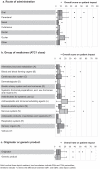Medicine shortages: impact behind numbers
- PMID: 36918981
- PMCID: PMC10013985
- DOI: 10.1186/s40545-023-00548-x
Medicine shortages: impact behind numbers
Abstract
Introduction: Current research to assess the impact that medicine shortages have on patients is limited to general aspects, such as the prevalence of shortages and product characteristics. The aim of this study is to assess the overall impact that medicine shortages have on economic, clinical, and humanistic outcomes.
Methods: A cohort of all known products in shortage in the Netherlands between 2012 and 2015 were characterized by their route of administration, anatomical therapeutic chemical class, and whether they were originator or generic products. A representative sample of 324 shortages (18% of all shortages) was rated as having low, medium, or high impact on the five elements that determine the impact of shortages on patients: availability of an alternative product, underlying disease, susceptibility of the patient, costs (for patients and society at large), and number of patients affected. Ratings were converted into numerical scores per element and multiplied to obtain an overall impact score.
Results: Two elements were most frequently rated as having a high impact: disease (29%) and costs (20%). Nearly half of the shortages (47%) rated high on at least one element, while nearly 10% rated high on multiple elements. Thirty percent of the shortages rated high on direct impact, which is represented by these elements: alternative product and disease. An additional 17% of the shortages rated high on indirect impact, which is represented by these elements: costs, susceptibility, and number of patients. High impact scores could not significantly be attributed to characteristics of the products in shortage.
Conclusions: An assessment of the medicine shortages' impact using a framework based on economic, clinical, and economic outcomes showed that all three outcomes affect the overall impact that medicine shortages have on patients.
Keywords: ECHO model; Framework; Impact; Medicine shortages; Patient outcomes.
© 2023. The Author(s).
Conflict of interest statement
The authors declare that they have no known competing personal or financial interests that could influence this research.
Figures





Similar articles
-
Impact of medicine shortages on patients - a framework and application in the Netherlands.BMC Health Serv Res. 2022 Nov 17;22(1):1366. doi: 10.1186/s12913-022-08765-x. BMC Health Serv Res. 2022. PMID: 36397073 Free PMC article.
-
What impact does medicines shortages have on patients? A qualitative study exploring patients' experience and views of healthcare professionals.BMC Health Serv Res. 2021 Aug 17;21(1):827. doi: 10.1186/s12913-021-06812-7. BMC Health Serv Res. 2021. PMID: 34404420 Free PMC article.
-
Proposal for Handling of Medicine Shortages Based on a Comparison of Retrospective Risk Analysis.Int J Environ Res Public Health. 2022 Mar 30;19(7):4102. doi: 10.3390/ijerph19074102. Int J Environ Res Public Health. 2022. PMID: 35409787 Free PMC article. Review.
-
The impacts of medication shortages on patient outcomes: A scoping review.PLoS One. 2019 May 3;14(5):e0215837. doi: 10.1371/journal.pone.0215837. eCollection 2019. PLoS One. 2019. PMID: 31050671 Free PMC article.
-
Medicine shortages: Product life cycle phases and characteristics of medicines in short supply-A register study.Front Pharmacol. 2022 Jun 27;13:943249. doi: 10.3389/fphar.2022.943249. eCollection 2022. Front Pharmacol. 2022. PMID: 35833029 Free PMC article.
Cited by
-
Drug supply and assurance: a cross-sectional study of drug shortage monitoring varieties in China.BMC Public Health. 2024 Jul 30;24(1):2048. doi: 10.1186/s12889-024-19361-5. BMC Public Health. 2024. PMID: 39080661 Free PMC article.
-
Impact of medicine shortages on hospital practice: role of a multidisciplinary medicine shortages team.Int J Clin Pharm. 2024 Dec;46(6):1563-1569. doi: 10.1007/s11096-024-01772-4. Epub 2024 Jul 15. Int J Clin Pharm. 2024. PMID: 39007990
-
Price increase negotiations to address drug shortages in South Korea's national health insurance.Front Pharmacol. 2023 Dec 4;14:1307462. doi: 10.3389/fphar.2023.1307462. eCollection 2023. Front Pharmacol. 2023. PMID: 38111380 Free PMC article.
-
Addressing Drug Shortages at Mediclinic Parkview Hospital: A Five-Year Study of Challenges, Impact, and Strategies.Cureus. 2024 Dec 25;16(12):e76377. doi: 10.7759/cureus.76377. eCollection 2024 Dec. Cureus. 2024. PMID: 39867009 Free PMC article.
-
Impact of Antibiotic Shortages on Antibiotic Utilisation in the Community.Pharmacoepidemiol Drug Saf. 2025 Feb;34(2):e70107. doi: 10.1002/pds.70107. Pharmacoepidemiol Drug Saf. 2025. PMID: 39870483 Free PMC article.
References
-
- World Health Organization. Medicines. Accessed: 12 January 2023. https://www.who.int/health-topics/medicines
-
- Besancon L, Chaar B. Report of the international summit on medicines shortage 2013. Final report. 2013:24. https://www.fip.org/files/fip/publications/FIP_Summit_on_Medicines_Short.... Accessed 12 Jan 2023.
-
- World Health Organization. Addressing the global shortage of medicines and vaccines. WHA Resolution; Sixty-ninth World Health Assembly, 2016. WHA69.25. http://apps.who.int/medicinedocs/en/d/Js22423en/. Accessed 24 Nov 2022.
LinkOut - more resources
Full Text Sources
